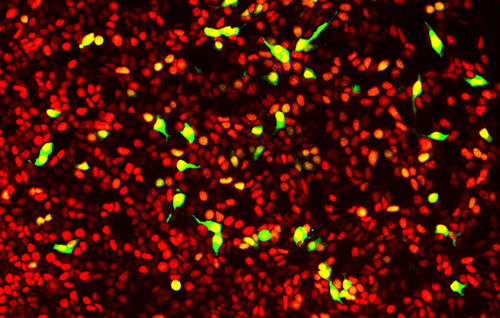Fluorescent Biosensors Reveal the Inner Workings of Living Cells
Anne Marie Quinn, founder of Montana Molecular, shares how it’s possible to measure, in real time, multiple signaling pathways inside a living cell
G protein-coupled receptors (GPCRs) form the fundamental basis of different cellular responses: vision, taste, smell, pain, fighting infections, having mood swings, among others. In response to external stimuli, GPCRs trigger signaling pathways that affect all kinds of biological functions in nearly every cell type. A method to understand these basic cellular mechanisms in health and disease involves fluorescent biosensors that measure intracellular GPCR signaling.

HEK293T cells carrying a green cell stress sensor and a constitutively expressed nuclear red fluorescent protein.
We recently caught up with Anne Marie Quinn, the founder of Montana Molecular, a company that makes and supplies fluorescent assays for detecting signaling pathways in living cells. In this SelectScience® interview, Quinn discusses their one-of-a-kind fluorescent biosensors and summarizes how it’s now possible to measure, in real time, multiple signaling pathways inside a living cell.
“Montana Molecular is the first company that developed really bright genetically-encoded sensors for specific GPCR signaling pathways. We modified the new extremely bright green fluorescent protein, mNeon, so it could be used in a single fluorescent protein sensor. Our modification meant that we could produce much higher signal-to-noise than the traditional FRET-based sensors,” says Quinn, a scientist who worked in academia and biotech for years, and then founded the company to aid the use of biosensors in various applications.
To tease out the inner workings of a cell, one would need to use robust fluorescent sensors that identify intracellular signaling pathways. “Our very first product was for detection of diacylglycerol (DAG) an important component of GPCR signaling through the Gq pathway. We specifically wanted to differentiate between Gs, Gi and Gq signaling,” notes Quinn. “This is an important goal for both drug discovery and basic research.”
About 40% of current drugs target GPCR signaling. GPCRs can trigger changes in (i) cyclic AMP (cAMP) pathways and (ii) the phosphatidylinositol pathway. Upon ligand binding, the Gs-coupled GPCR receptor activates adenylyl cyclase that in turn produces cAMP, governing important cellular responses. Gi-coupled GPCR receptors, however, inhibit adenylyl cyclase and cAMP production. The phosphatidylinositol pathway, on the other hand, is triggered by the Gq-coupled receptors. In Gq-coupled signaling, DAG and intracellular calcium act as second messengers, ultimately influencing cell functions.

